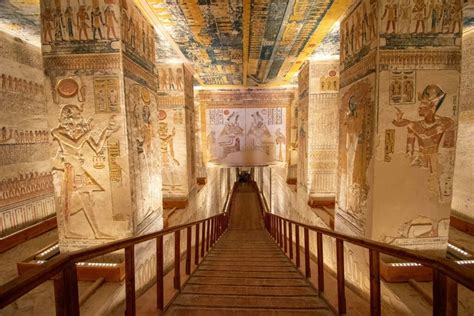🏺 Valley of the Kings: A Journey Through Time in the Heart of Egypt’s Desert
Step into a Land of Secrets and Eternal Kings
Imagine standing in a silent desert, surrounded by sandstone cliffs etched with the stories of millennia. The golden sun warms the earth, and beneath these ancient rocks lies one of the greatest secrets of antiquity — the Valley of the Kings, a sacred burial ground where Egypt’s most powerful rulers were laid to rest along with their treasures and dreams of immortality.
🌄 Why Was the Valley of the Kings Chosen?
In the early days, Egypt’s pharaohs built grand pyramids as their eternal homes. But as tomb robbing became widespread, a new solution was needed. Pharaoh Thutmose I made a revolutionary decision: to bury kings in a hidden valley in the Theban mountains.
Why this valley?
-
Surrounded by cliffs, it was naturally concealed and protected.
-
The dry, rocky soil preserved bodies and artifacts exceptionally well.
-
It allowed for elaborate, decorated tombs carved directly into the rock.
🔦 Entering the Hidden Tombs
Picture yourself on a narrow, dusty trail between the cliffs. You reach a small, carved doorway, step inside, and descend into darkness. Suddenly, walls explode with brilliant colors—scenes of gods, pharaohs, and the journey through the afterlife.
These aren't just decorations. They are magical spells and divine instructions to guide and protect the king beyond death. You'll meet gods like:
-
Anubis – the jackal-headed guardian of the dead.
-
Osiris – the god of resurrection and eternal life.
Each chamber had a purpose: burial, ritual, or spiritual defense. Inscriptions warned of divine punishment for those who disturbed the tombs.
👑 Famous Tombs and Kings
• Tutankhamun
The boy king whose nearly intact tomb was discovered by Howard Carter in 1922, astonishing the world with gold treasures, a golden mask, and symbolic artifacts.
• Ramesses II
Known as “The Great,” he ruled for 67 years. His tomb showcases his military victories and divine status. Builder of Abu Simbel, he chose the Valley for his eternal rest.
• Seti I
His tomb is considered the most beautiful and detailed, filled with vibrant paintings and texts from the Book of Gates and Book of Caverns.
• Hatshepsut
A powerful queen who ruled as pharaoh. Though buried in the Valley of the Queens, her artistic and architectural influence deeply shaped the Valley of the Kings.
🛕 Life in the Valley: Workers Behind the Majesty
A specialized community of artists, engineers, and laborers lived nearby, mainly in Deir el-Medina. Archaeological findings show they were:
-
Well-paid and respected.
-
Skilled in construction, carving, and religious symbolism.
-
Living in a tightly organized and structured society.
🧭 Incredible Archaeological Discoveries
-
Secret Passages: Many tombs still have unexplored tunnels.
-
Funerary Statues & Tools: Servant figurines and ritual items meant to serve the king in the afterlife.
-
Manuscripts & Spells: Sacred texts like the Book of the Dead and Book of Gates adorned walls with incantations for the afterlife.
💫 The Valley of the Kings — Where History Meets the Soul
Every stone, every color, every passage in the Valley echoes the belief in life after death. As you walk these ancient paths, you feel the presence of kings and gods. It's not just a burial site — it’s a timeless story, told in silence and shadow, that still echoes through the sands of Egypt.


